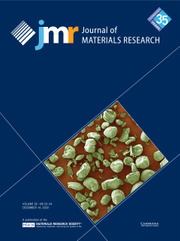Article contents
Antiferromagnetic behavior in Y–Ba–(Cu1−xScx)–O
Published online by Cambridge University Press: 31 January 2011
Abstract
We report the results on x-ray diffraction and magnetic susceptibility study of Y–Ba–(Cu1−xScx)–O. The materials were prepared in a stoichiometry corresponding to Y1Ba2(Cu1−xScx)3O7. Although x-ray analysis reveals the increasing presence of a subtle second phase with increasing Sc content, the superconducting transition temperature and resistivity did not change substantially in the composition range 0.0 x ≤ 0.15. In contrast, the magnetic susceptibility studies showed dramatic changes. Although Sc3+ has no spin by itself, an enhanced paramagnetic Curie susceptibility was observed above Tc with a moment of 1.5 μB per Sc. At 16 K a sharp cusp is observed in the temperature dependent susceptibility corresponding to the onset of a three-dimensionally ordered antiferromagnetic state. These results are discussed in terms of an additional previously unreported phase of Y–Ba–(Cu–Sc)–O that has an antiferromagnetic Néel temperature of 16 K. For composition of x = 1.0, a new phase is formed which is nonmagnetic.
Information
- Type
- Rapid Communications
- Information
- Copyright
- Copyright © Materials Research Society 1989
References
- 2
- Cited by

